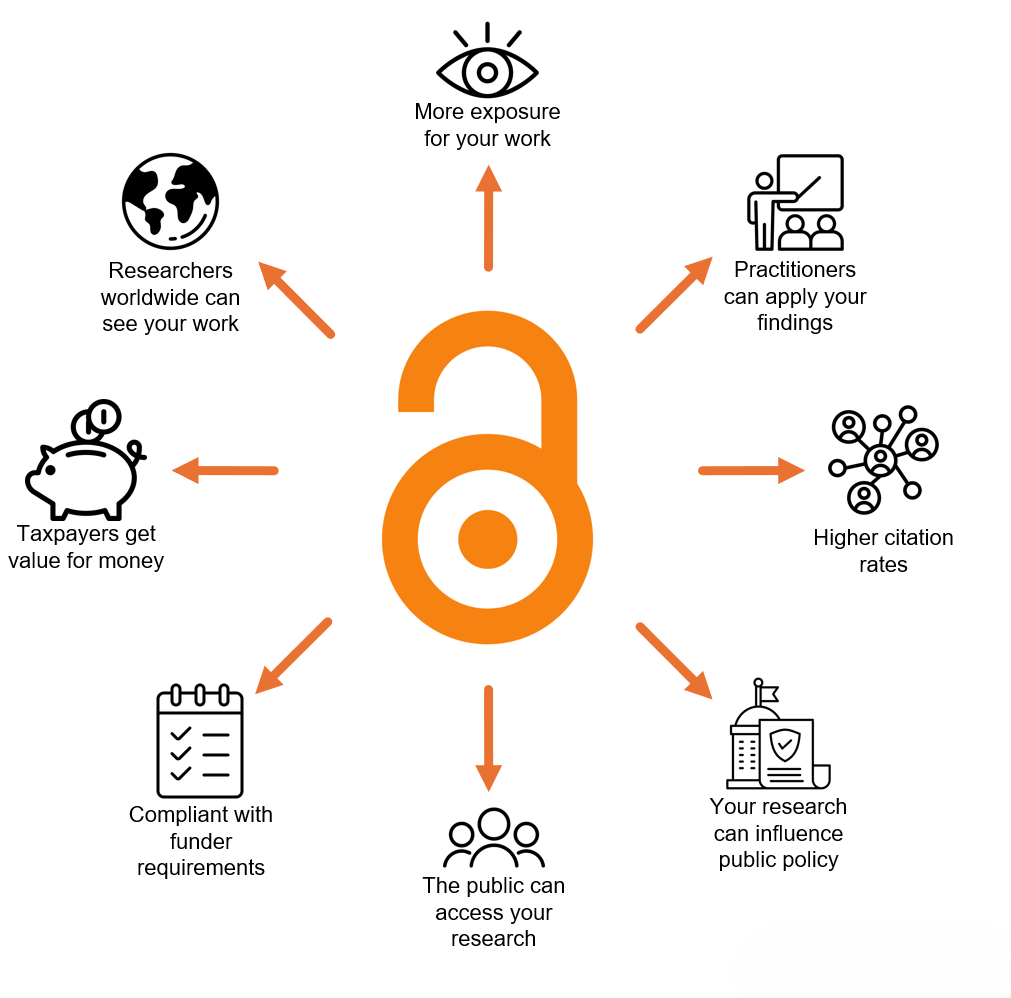Open Access (OA) is about more than just making materials freely available online. Open Access infrastructure allows people to share their work while setting boundaries in regard to attribution, reuse, and archiving. When scholarly outputs are published in OA platforms (usually journals and repositories or archives), publicly funded research can be freely accessed by the global community. OA is compatible with the peer review process, and academic journals are increasingly making their content available via OA publishing models. The Australian Research Council (ARC) and the National Health and Medical Research Council (NHMRC) both have Open Access policies which guide their dissemination mandates.
The following video 'Open Access Explained!' was created by Piled Higher and Deeper (PHD Comics).
Why is Open Access so important in higher education?
OA publications are cited more than those published with traditional models. OA journal articles are cited 18% more than articles that are behind subscription paywalls (Piwowar et al., 2018). There is also an increased diversity of citation sources for OA articles (Huang et al., 2024).
OA publications have more potential visibility and and influence. Easier access to scholarly publications make global research partnerships more feasible (Bruegelmans et al, 2018).
OA benefits the global scholarly community. Publishing in OA form means that developing nations can better take part in global scholarship, resulting in a more equitable research environment.
OA accelerates the dissemination of knowledge. Science disciplines are increasingly publishing their (non-peer reviewed) work in pre-print repositories, which allow for early discussion and presentation of research findings before the final peer review process begins. Pre-print repositories are freely available and allow for transparent discussion and critique (Teixeira da Silva & Dobránszki, 2019).
OA benefits the taxpayer. Research is often publicly funded, yet it is not necessarily publicly accessible due to outputs being published behind subscription paywalls. Making material freely available via OA platforms allows the public to access the latest research findings.
 Why open access? ©2024 by Danny Kingsley & Sarah Brown CC BY 4.0
Why open access? ©2024 by Danny Kingsley & Sarah Brown CC BY 4.0
|
Traditional
|
In the traditional, toll-based publishing model, authors give up copyright to publishers, and published manuscripts are locked behind paywalls. Only those who pay a fee or have access to institutional subscriptions can gain access. |
|---|---|
|
Green
|
In the Green access model, a copy of a manuscript is permanently archived in an OA repository, often at a University (like ResearchOnline@ND). Anyone from the public is then able to access copies of the research, sometimes after an embargo period. |
|
Gold
|
In the Gold access model, the author publishes their manuscript in an OA journal. The author may have to pay an "article processing charge" to do this (APC). The research is then freely available for the public to access. |
|
Hybrid
|
In the Hybrid access model, the author publishes their manuscript as OA within a traditional (toll-based) journal. |
|
Bronze
|
In the newer Bronze access model, a publisher makes an article freely available on a site but without a license that clearly identifies the article as OA (Piwowar et al, 2018). This means that there are no guarantees that Bronze articles will stay openly accessible on a permanent basis. |
|
Diamond
|
In the Diamond access model, the manuscript is published as OA by a non-profit organisation, with a license that only allows for non-commercial reuse. The are no fees for either the author or the reader (Fuchs & Sandoval, 2013). |
Australasian Open Access Strategy Group (n.d.). Why Open Access? https://archive.oaaustralasia.org/why-open-access/
Breugelmans, J., Roberge, G., Tippett, C., Durning, M., Struck, D. B., & Makanga, M. M. (2018). Scientific impact increases when researchers publish in Open Access and international collaboration: A bibliometric analysis on poverty-related disease papers. PLOS One, 13(9), 1-20. https://doi.org/10.1371/journal.pone.0203156
Fuchs, C., & Sandoval, M. (2013). The Diamond model of Open Access publishing: Why policy makers, scholars, universities, libraries, labour unions and the publishing world need to take non-commercial, non-profit open access serious. TripleC, 11(2), 428-443. https://doi.org/10.31269/triplec.v11i2.502
Huang, C.-K., Neylon, C., Montgomery, L., Hosking, R., Diprose, J. P., Handcock, R. N., & Wilson, K. (2024). Open access research outputs receive more diverse citations. Scientometrics, 129(2), 825–845. https://doi.org/10.1007/s11192-023-04894-0
Piwowar, H., Priem, J., Larivière, V., Alperin, J. P., Matthias, L., Norlander, B., ... & Haustein, S. (2018). The state of OA: A large-scale analysis of the prevalence and impact of Open Access articles. PeerJ, 6 (4375). https://doi.org/10.7717/peerj.4375
SimpleIcon. (2016). SimpleIcon interface unlocked padlock [Image]. https://commons.wikimedia.org/wiki/File:Simpleicons_Interface_unlocked-padlock.svg
Teixeira da Silva, Jaime A, & Dobránszki, J. (2019). Preprint policies among 14 academic publishers. The Journal of Academic Librarianship, 45(2), 162-170. https://doi.org/10.1016/j.acalib.2019.02.009
In support of Open Access, the University of Notre Dame Australia has declared the following Open Access Statement of Principle:
"The University supports the underlying principles of open scholarship by making research outputs freely available online"
Notre Dame makes research outputs freely available to the public in the institutional repository ResearchOnline@ND. The University is also a member of Open Access Australasia (OAA).
Copyright © 2025 The University of Notre Dame Australia | CRICOS Provider Code: 01032F | TEQSA PRV12170 | RTO Code 0064

